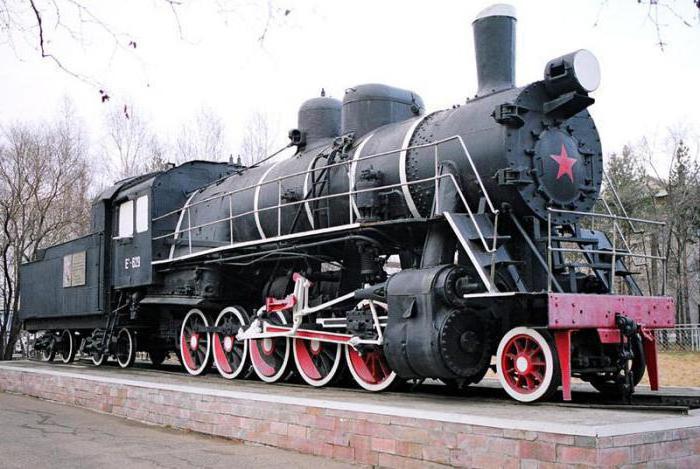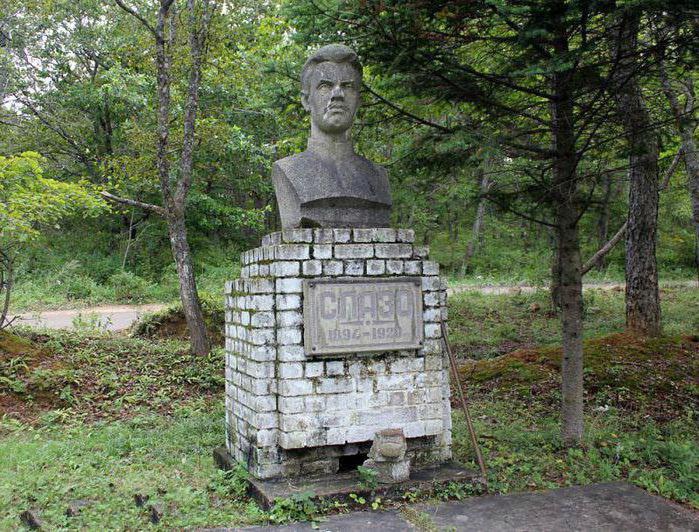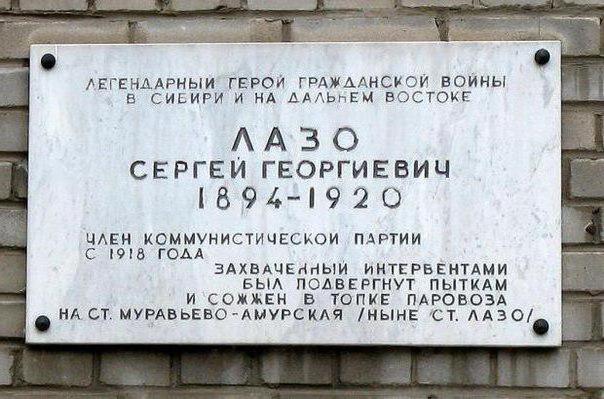In Soviet times, the name of such a hero as Sergei Lazo was very popular. His biography was an example of devotion to the formation of Soviet power. Particularly noteworthy was the fact that Lazo was a nobleman from a wealthy family. And a beautiful legend was built about his death. But what was Sergey Georgievich Lazo really like? The biography below is an attempt to answer this question.

In Soviet books and textbooks on the history of the civil war, the version of the death of S. Lazo was as follows: the White Guards threw him into the furnace of a steam locomotive, where he, along with Alexei Lutsky and Vsevolod Sibirtsev, burned down for the cause of the revolution (this steam locomotive is shown in the photo above). Details, however, varied. No one was interested anymore, at the hands of which particular White Guards they died, at what station this happened and how they ended up there. But in vain. A careful examination of this issue reveals a very interesting story. But first things first.
The origin of Lazo, the entry into the ranks of the Social Revolutionaries
Sergei Lazo was born in Bessarabia in 1894, and he died at the age of 26, far from his homeland for the idea of communism. Sergey was a native of a wealthy noble family. Lazo Sergey Georgievich studied at the Moscow State University on a physics and technology, and during the First World War he was mobilized. In the rank of ensign in 1916, Lazo was in Krasnoyarsk, where he joined the Socialist Revolutionaries. This choice was not accidental: as contemporaries noted, Sergei from childhood was distinguished by an increased sense of justice and maximalism, reaching the point of romanticism.
Meeting with Lenin, a mutiny in Krasnoyarsk
In the spring of 1917, a 20-year-old romantic arrived in Petrograd as a deputy from the Krasnoyarsk Council. Then the only time in his life he saw Lenin live. Sergei really liked the leader’s radicalism, and he decided to become a Bolshevik. Upon returning to Krasnoyarsk, Sergey Lazo led a rebellion in October 1917.
The fight with the chieftain Semenov

According to the version of Soviet textbooks, in 1918, when the party sent Lazo to Transbaikalia, he successfully defeated ataman Semenov there. However, in reality, everything was different. Sergey Lazo, a romantic revolutionary, fought with the chieftain for six months, but could not defeat him. Several times he pushed Semenov back to Manchuria, but the ataman again advanced and drove north to Lazo. And in the summer of 1918, Sergei Lazo was caught in pincers between Czechoslovakians and Semenov. He had to flee from Transbaikalia. In principle, Lazo could not defeat Ataman, since Semenov was a significant figure in Dauria, enjoyed support and authority among the population, and nobody knew Sergei Georgievich there. In addition, the army of Sergei enjoyed a bad reputation because of its criminal orientation. It is known that his detachments were staffed with bastards and criminals, whom the Bolsheviks agreed to release if they supported the revolution. A lot of trouble for Sergey Georgievich was brought by these soldiers, who carried out “requisition” from the local population. However, he had to put up with this, since each person was counted.
Two female commissioners
Two female commissioners served in the Lazo squad. The personality of Nina Lebedeva is especially remarkable. She was the adopted daughter of the former head of Transbaikalia and an adventurer by nature. While still a gymnasium student, she joined the Socialist Revolutionaries, took part in leftist terror, and then went over to the anarchists. It was she who commanded in the detachment of Sergey Lazo, which consisted of criminal elements. She sprinkled her speech with such obscene expressions that even seasoned criminals shook their heads.
Its direct opposite was the second commissioner, Olga Grabenko. It was a beautiful black-browed girl who liked Sergey very much. He began to look after her, and soon they got married. In 1919, they had a daughter, Ada Sergeevna, who later prepared a book about Sergey Lazo, "Lazo S. Diaries and Letters."
Surroundings, flight to Vladivostok
However, the young were unlucky. The detachment of Sergey the next day after the wedding was surrounded. Olga and Sergey left the army and tried to hide in Yakutsk. However, in this city there was a “white” coup, so they had to go to Vladivostok.
The authorities in Primorye were interventionists and White Guards, so Lazo arrived in Vladivostok illegally. They soon found out about this and a large reward was promised for his capture. Ataman Semenov gave money for the head of his opponent. When the bloodhounds attacked the trail of Sergei, the Bolsheviks sent him deep into Primorye to work in partisan detachments.
Fatal mistake Lazo
In early 1920, after the news of the fall of Kolchak in Siberia, the Bolsheviks of Vladivostok decided to overthrow his governor, General Rozanov. Lazo himself insisted on this. However, it later turned out that it was his fatal mistake.
To storm Vladivostok, at that time filled with Japanese troops, meant nothing more than suicide. However, on January 31, 1920, partisans occupied the city. Rozanov fled to Japan by boat. At first, the interventionists were just observers. In the city, there were about 20-30 thousand Japanese, and the Bolsheviks - only a few thousand, so you should be careful. Under these conditions, Lazo set out to proclaim Soviet power in Vladivostok. The fighters, among whom were criminals, began to carry out executions of the "bourgeoisie" (which included everyone who did not look like a complete rascal) and confiscation of property. The inhabitants turned to the Japanese garrison for help.
Speech by the Japanese, the arrest of Lazo
The Japanese speech took place on the night of April 4-5, 1920. Almost all the Bolshevik leaders and partisan commanders were arrested. Sergei Lazo was taken in the building of the former counterintelligence Kolchak, located on the street. Poltava, d. 6 (now - Lazo, 6). He went there at night in order to destroy documents. On April 9, he, along with Lutsk and Sibirtsev, was taken away towards the Rotten Corner. Olga Lazo rushed to the Japanese headquarters, but she was informed that her husband was in a guardhouse on Begovaya. Lazo Olga Andreevna went there. Sergei Lazo, however, disappeared.
The version of death that did not suit the Soviet regime
Only a month later, rumors began to spread about the death of Sergei Lazo, Sibirtsev and Lutsky. And in June 1920, they started talking about this as a fact. The first information appeared. Klempasko, the Italian captain, said that Sergei was shot at Egersheld and burned his corpse. This message appeared in many newspapers, it was distributed by world news agencies. However, the Bolsheviks did not like this version of Lazo’s death, and they decided to come up with a more beautiful one.
Eyewitness testimony
In September 1921, a steam engine driver suddenly appeared, who allegedly saw in May 1920 how the Japanese handed over three bags to Cossacks from Bochkarev’s detachment. Lazo, Sibirtseva and Lutskogo were pulled out of the bags and tried to put into a locomotive firebox. They resisted, and the Bochkarevians were tired of it. The prisoners were shot and put already dead in the furnace.

This story has been retold many times, while the name of its author has never been called. Apparently, he was not there. This story does not stand up to criticism. First of all, Sergey Lazo and two of his associates could not get through and fit in the firebox of a locomotive in three. The design of the machines of the 1910s simply did not allow this. In addition, it is not known at which station this event occurred. The driver pointed to Art. Ruzhino, and later in the literature appeared art. Muravyovo-Amurskaya. And why did the Japanese need to transfer Lazo and his friends to the Bochkarevites and take them many kilometers to places swarming with partisans? No one explained this - the Bolsheviks were not interested in the details.
Memory
In 1968, the biographical film "Sergey Lazo" was released. In 1985, a mini-series directed by Vasile Pascar "Life and Immortality of Sergei Lazo" appeared. It tells about the life path of this hero. Many streets and other geographical objects were named after him, several monuments were erected.